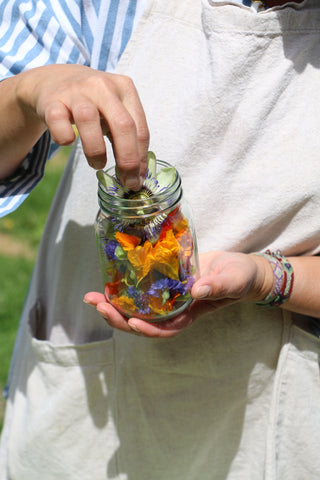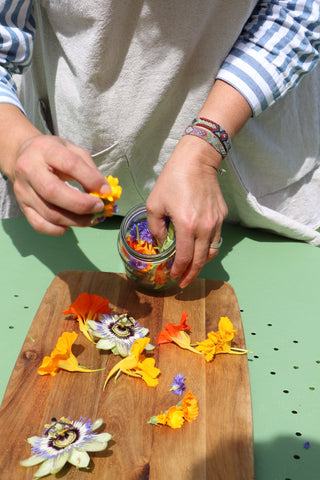flower tincture
By Amelia Perez
Since March 2019 I compose my garden. As if it were a symphony, I arrange and refine a tapestry of color and aroma. Marigolds, nasturtiums, passionflowers, rough agastaches and cornflowers, among others, all carefully tuned and balanced between them to achieve beauty as a result.
With this post I start a series of four beauty articles that have flowers as the protagonist. The tincture, The infusion, The maceration with salt and The maceration with oil.
Nasturtiums (Tropaeolum majus), Passionflowers (Passiflora incarnata), Calendula (Calendula officinalis), and Agastache (Agastache rugosa).
What is a tincture?
It is the cold maceration of a medicinal plant in ethyl alcohol. Alcohol is used to extract the medicinal substances contained in the plant. Unlike infusions, which must be consumed immediately, tinctures can be kept for months or even years, keeping the properties intact.
Preparation
We are going to need.
- Petals and garden flowers
- A glass container with a lid
- A bottle of alcohol + 40º (preferably vodka)
- Small containers with lids
The alcohol extracts the essential components of the plants to make tinctures. This method is highly effective, especially in the case of fibrous plants, roots and resins. Vodka is the best alcohol for this type of preparation, since it is colorless and almost tasteless, but rum, brandy and whiskey can also be used. Make sure that your chosen liquor has a 40% alcohol content, as otherwise the tincture will mold inside the bottle.

Fill the glass container with the flowers.
We fill a jar with the flowers and cover them with the chosen liquor up to the top. To remove any air bubbles, we pass a knife through the inside of the container. We close the jar with a tight lid and leave it in a dark and cool place for 8 days to a month, shaking it from time to time. I like to leave it in the sun for a day before maceration in a dark place.
We pour the alcohol into the jar covering the flowers.
After a month, we open the jar and drain the preparation through a strainer lined with muslin. Next we fill small jars with the strained liquid.
The alcohol in the liquor serves as a preservative, so it can last up to 2-3 years.
We must label the bottle with the date and type of tincture made.
During the preparation of tinctures, infusions and macerations, I feel a pleasure that relaxes and motivates me at the same time. They are small experiments of sensations in which I am inspired for future creations.
The bottle is a beauty to behold.
recommended flowers
I recommend the use of the following flowers for their properties:
-
Calendula (Calendula officinalis)
- Nasturtium (Tropaeolum majus)
- Passionflower ( Passiflora incarnata )
- Agastache (Agastache rugosa)
Korean mint (Agastache rugosa) is a plant native to East Asia known for its uses in gastronomy as a flavoring or salad dressing, and in traditional Chinese medicine as an antibacterial, antifungal, carminative, diaphoretic, febrifuge, and stomach tonic.
- Cornflower (Centaurea cyanus)
The astringent, diuretic, antibiotic and anti-inflammatory effect of cornflower also explains its usefulness in dental pain, sores on the tongue and on bleeding or irritated gums .
I wait for you in my next post: The infusion






5 comments
Que genial lo bueno que uno puede utilizar l planta fresca y no esperar secarla lo que me dentro en duda al utilizarla cuantas gotas son lo recomendable :)
Saludos muchas gracias
Buenas tardes,
Señora Amelia te escribo desde Bucaramanga Santander, Colombia
Quiero saber para qué sirven las tinturas de pétalos elaboradas con vodka
Hola Beatriz,
La tintura de flores es una manera de extraer las propiedades de las plantas en alcohol. Me gusta la capuchina por su vitamina C y sus propiedades antioxidantes, la caléndula por sus propiedades regeneradoras, antinflamatorias, la pasiflora por ser un relajante muscular. Me aplico un poco de titura, en la piernes despues de largos pasos por el campo. Saludos Amelia
Para qué sirve la tintura de flores?
Gracias, un saludo
Beatriz
Me ha gustado la forma de preparar la tintura ….creo que voy a experimentar y te cuento …Debo buscar las flores que voy a elegir …Un abrazo Amelia y estaré atenta al segundo post …La infusión